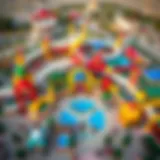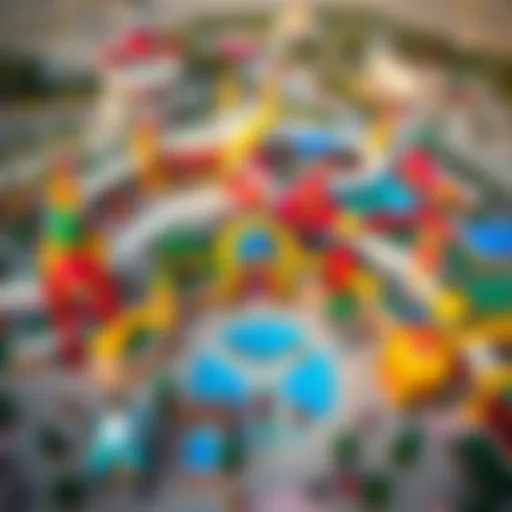Arabic Villa Design: Heritage Meets Modern Aesthetics
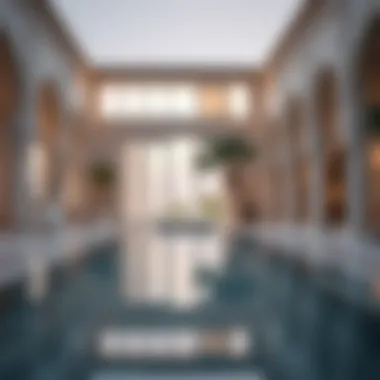

Market Insights
In recent years, the landscape of Arabic villa design has witnessed a blend of tradition and modernity, influencing current property trends significantly. With investments soaring in the Middle East, particularly in the Gulf countries, the demand for luxurious and culturally rich villas has been on the rise.
Current Property Trends
Investors and homebuyers are increasingly attracted to properties that reflect authenticity and sophistication. Here are some trends that stand out:
- Sustainable Materials: With a growing awareness of environmental impact, there is a noticeable shift towards sustainable building materials. For instance, natural stone and clay are not only traditional but eco-friendly.
- Open Spaces: Modern Arabic villas often incorporate open layouts that promote airflow and natural light, a nod to traditional designs that emphasized communal living.
- Smart Homes: Incorporation of smart technology in villas is becoming standard. Home automation systems that control lighting, security, and climate enhance not just convenience but also energy efficiency.
- Cultural Elements: Decorative motifs such as intricate mashrabiya (wooden lattice work) and colorful zellij (mosaic tile) continue to be focal points. These elements serve as a bridge between the past and future, preserving cultural heritage in a modern context.
Investment Opportunities
The property market in the Middle East, especially the UAE and Saudi Arabia, is ripe with investment opportunities. Notably:
- Luxury Developments: There is a high demand for luxury villas in prime locations, particularly those that offer scenic views and proximity to urban amenities.
- Tourism Influence: The influx of tourists seeking authentic experiences fuels the demand for traditional-style villas, resulting in profitability for rental properties.
- Government Initiatives: Many governments are offering incentives for foreign investors, including long-term visas tied to property ownership, enhancing the attractiveness of investing in villa properties.
"Investment in Arabic villa real estate is more than just property ownership; it’s about embracing a lifestyle steeped in rich heritage while adapting to modern demands."
Practical Tips
Guide to Buying Property
For those considering purchasing an Arabic villa, here are some essential tips to navigate the complexities of the property market:
- Research Thoroughly: Know the area, property value trends, and local regulations. Online platforms, like Britannica or local real estate websites, can provide valuable insights.
- Consider Construction Quality: Assess the materials used and craftsmanship. Arabic villas should reflect superior quality and authentic design.
- Engage Local Real Estate Experts: They can guide you through the buying process, providing insights into the best neighborhoods and potential for appreciation.
Renting vs. Buying: What You Need to Know
The choice between renting and buying can be tricky. Here’s a breakdown to consider:
- Renting allows flexibility. If you're unsure of your long-term plans, renting a villa can provide an opportunity to test living in a new area without a hefty commitment.
- Buying, on the other hand, offers investment potential and the ability to customize your home. Over time, the property could appreciate, making it a strong long-term investment.
Prologue to Arabic Villa Design
Arabic villa design serves as a tangible connection to the rich cultural and historical tapestry of the Middle East. Each villa tells a story that reflects not only architectural ingenuity but also the societal values and lifestyles of the people who inhabit them. This article aims to peel back the layers of Arabic villa design, providing an in-depth exploration of its distinctive features, materials, and the evolving landscape of modern adaptations. Such insights are invaluable for investors, homeowners, real estate agents, tenants, and developers who are keen to understand how these structures embody a blend of heritage and contemporary aesthetics.
Cultural Significance
The cultural significance of Arabic villas extends deep into the fabric of the region's identity. These villas are not just places where families reside; they are landmarks that represent cultural expressions, traditional values, and the Islamic way of life. The layout often prioritizes privacy, a concept that is highly esteemed in Arab culture. The use of elegant courtyards and intricate water features showcases a deep appreciation for nature and tranquility, reflecting the values of hospitality and community.
Artisans have played a crucial role in preserving this cultural heritage through their craftsmanship. The detailed tile work, calligraphy, and intricate carvings seen in these villas — all contribute to a broader narrative that connects residents with centuries of history.
Moreover, these villas stand as symbols of wealth and status, often passed down through generations. They are spaces where memories are created, and families gather, thus reinforcing the significance of familial bonds intrinsic to Arabic culture.
Historical Context
The historical context of Arabic villa design can be traced back to the ancient civilizations of the region, including the Mesopotamians and the Phoenicians, who laid the groundwork for sophisticated architectural practices. The golden age of Islamic architecture, during the Umayyad and Abbasid caliphates, marked a pivotal period where architectural styles flourished. Structures were often adorned with geometric patterns and calligraphic inscriptions that conveyed both artistry and religious significance.
As trade routes expanded, influences from Persian, Ottoman, and even European architectural styles began to permeate villa designs. This confluence of styles led to the emergence of unique elements such as domes, arches, and mashrabiyas. Each feature has historical roots, contributing to a sense of place that aligns with the diverse cultures that have inhabited the region.
However, as modernization cascades through contemporary society, the essence of these traditional designs is being challenged and reinterpreted. Understanding this historical context is crucial for today’s stakeholders, as it allows them to appreciate the intricate balance between maintaining heritage and embracing innovation in Arabic villa design.
Key Architectural Features
In the realm of Arabic villa design, architectural features act as the backbone, showcasing tradition while accommodating contemporary needs. These elements not only contribute to the aesthetic appeal but also serve practical purposes in the hot climate of the Middle East. Key features such as courtyards, mashrabiya, and domes and arches are emblematic of this dual purpose, blending form and function harmoniously.
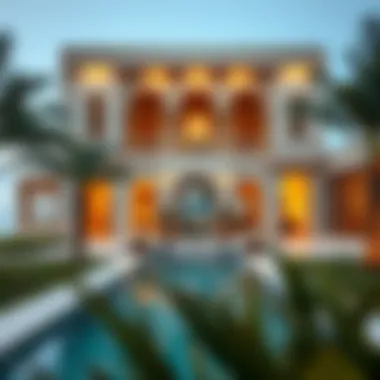

Courtyards and Gardens
Courtyards, often referred to as the very heart of Arabic villas, offer a private sanctuary while also promoting natural ventilation. They are intentionally designed to provide a cool refuge from the scorching sun. For instance, consider a villa where the courtyard flourishes with date palms, fragrant jasmine, and vibrant bougainvillea. Such landscapes not only create a serene atmosphere but also encourage family gatherings and social interactions.
Moreover, these spaces are crucial for privacy and security. Surrounded by high walls and adorned with lush greenery, they invite light and air while keeping prying eyes at bay. The use of reflecting pools in some designs enhances visual beauty and creates a calming sound of water, which is essential in mitigating the heat.
"In the middle of a bustling Dubai, a villa’s courtyard can feel like an oasis, a reflection of culture and connection to nature."
Mashrabiya: A Design Element
The mashrabiya is a traditional wooden latticework that serves multiple purposes. Beyond its intricate beauty, it plays a vital role in climate control by allowing air circulation while deflecting harsh sunlight. Inside the villa, this design creates a softer light, casting beautiful shadows and patterns on the floors and walls. This subtle dance of light is something no other window treatment can quite replicate.
In modern adaptations, architects often reimagine the mashrabiya using contemporary materials like steel or glass. This fusion of old and new not only honors tradition but also meets today’s demand for sustainability. For instance, a balcony adorned with modern mashrabiya can enhance outdoor spaces, providing shelter from the sun, allowing homeowners to enjoy fresh air without the harsh rays interrupting their leisure time.
Domes and Arches
Domes and arches are fundamental in Arabic architectural expression, representing strength and beauty. The elegant curve of a dome can transform a room, guiding the eye upward and creating an impression of spaciousness. This is particularly valuable in smaller villas, where maximizing the feeling of space is essential.
Arches, on the other hand, are not merely structural components; they’re artistic elements that carry cultural significance. From the classic pointed arches to more modern takes, they create an engaging aesthetic that can evoke a sense of history. They also contribute to the cooling effect in buildings, as they allow air to circulate more effectively throughout spaces.
In recent designs, architects have experimented with larger spans and innovative materials to enhance their functionality. The result is an exhilarating blend of the classic Arabic style with modern sensibilities – making these features timeless representatives of both heritage and design innovation.
Materials Used in Construction
When it comes to Arabic villa design, the significance of construction materials cannot be overstated. These materials are not just functional; they reflect the cultural and aesthetic sensibilities of the region. Over the years, the choice of materials has evolved, influenced by climatic conditions, availability, and contemporary design philosophies. Let’s delve into why these materials matter, focusing on two primary sources: local stone and clay, as well as wood.
Local Stone and Clay
The use of local stone and clay in construction is a practice deeply rooted in the cultural heritage of the Arab world. Builders have traditionally favored materials sourced from their environment, thus ensuring that their homes are not just livable spaces, but also a connection to the land.
Opting for stone, particularly limestone and sandstone, provides durability while allowing structures to breathe in hot climates. Moreover, these materials often exhibit a unique texture and color, which can harmonize beautifully with the surrounding landscape. This is crucial for homeowners and investors alike, as a villa built from locally sourced stone often holds more historical and aesthetic value.
Some key benefits of using local stone and clay include:
- Thermal Efficiency: Clay, being a natural insulator, helps maintain a comfortable temperature indoors, keeping heat out in the summer and holding warmth during cooler nights.
- Aesthetic Appeal: The natural colors and formations of stones add character and charm, giving each villa a unique look.
- Sustainability: By using locally sourced materials, the carbon footprint associated with transportation is reduced, aligning with modern sustainable practices.
In addition, integrating clay into designs serves beyond structural purposes. It allows for intricate detailing, such as mud plastering which gives a rustic finish that is often sought after for its authenticity.
"The soul of a villa often lies within the walls made of strong stone and harmonious clay, anchoring it in its environment."
Wood: Traditional and Modern Usage
Wood has its own special charm in Arabic villa construction. Traditionally, it was utilized in the form of beams, doors, and window frames, crafted from local varieties such as palm, cedar, and pine. However, modern adaptations are also embracing engineered woods to meet the demands of contemporary designs while respecting traditional aesthetics.
Traditional usages typically focus on solid wood, which not only boasts durability but also imparts a sense of warmth to the interiors. The ornamentation often found in wooden elements reflects intricate designs that are characteristic of Arabic artistry. These details add depth and a sense of richness to the living spaces.
On the flip side, modern usage has seen a rise in the integration of wood panels and composite materials, making the architecture versatile and aligned with current sustainability trends. Using engineered wood products can streamline the construction process while ensuring that the sacrifice in quality is minimal.
Here are some considerations when it comes to wood in villa designs:
- Sustainability: With a focus on sustainable practices, utilizing responsibly sourced wood ensures that a villa's ecological footprint remains low.
- Customizability: Modern manufacturing processes allow for bespoke wood designs, catering to individual tastes, thus enhancing the villa’s market appeal.
- Durability: Advances in treating wood also increase longevity, resisting pests and environmental wear and tear.
In summary, incorporating local stone, clay, and wood into the construction of Arabic villas works harmoniously with both heritage and contemporary needs. These materials not only define the architectural style but also embody the ethos of sustainability and resilience.
Decorative Elements in Arabic Villas
The beauty of Arabic villas is not solely in their structural design or the materials used in their construction, but also in the decorative elements that adorn them. These intricate details enhance the villa's aesthetic appeal and reflect the cultural and artistic heritage of the region. Key decorative aspects include tile work, mosaics, calligraphy, and friezes, which encapsulate stories and traditions, thus serving a dual purpose of beautification and cultural storytelling.
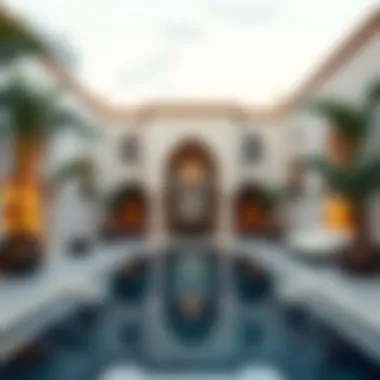

Decorative elements in Arabic villas often have symbolic meanings, intertwining functionality with artistry. They are not just ornaments but tell tales of the people, their history, and their beliefs. For investors, homeowners, and architects alike, understanding these elements can provide insights into the villa's design philosophy and investment potential.
Tile Work and Mosaics
Tile work and mosaics are standout features in many Arabic villas. The use of zellige tiles, characterized by colorful geometric patterns, exemplifies the artistic flair that defines Arabic design. Each piece is meticulously crafted and arranged, resulting in visually striking surfaces. The patterns often extend from the floors to the walls and ceilings, creating an immersive experience.
Tiles are not just visually appealing; they serve practical purposes as well. Their durability makes them suitable for various climates, particularly the hot and humid weather found in many Middle Eastern regions. Besides, the cool surface of tiles provides comfort underfoot, which is essential in hot temperatures.
Here are some notable aspects of tile work and mosaics in Arabic villas:
- Geometric Patterns: Symbolizing infinity and unity, these patterns draw visitors in, making them feel enveloped in an artistic embrace.
- Color Variety: The vibrant hues used in tile designs reflect cultural celebrations, adding life and spirit to any space.
- Cultural Symbolism: Each design often embodies local fables or historic significance, making tiles both an artwork and a cultural artifact.
"Tile work in Arabic architecture is often more than mere decoration; it embodies centuries of tradition and craftsmanship, echoing the voice of the past in the present."
Calligraphy and Friezes
Calligraphy and friezes are another important facet of decorative elements in Arabic villas. Known for their intricate designs, these elements are often employed both inside and outside the villas. Calligraphy in Arabic culture does not only communicate words; it embodies an art form revered for its beauty, elegance, and expressiveness.
Friezes featuring calligraphic art usually convey religious verses, poetic lines, or proverbs that resonate with cultural values. They serve as reminders of faith, wisdom, and beauty, enriching the living environment.
Key points regarding calligraphy and friezes include:
- Spiritual Essence: Many villas include verses from the Qur'an or poetry that emphasizes moral and spiritual teachings.
- Artistic Expression: The styles vary significantly, from flowing scripts to geometric orientations, showcasing the skills of calligraphers.
- Embracing Heritage: Integrating these decorative elements is a nod to preserving history, making the spaces not just residential but also culturally significant.
In summary, decorative elements in Arabic villas are essential for capturing the unique blend of tradition and modernity. These features not only beautify spaces but also anchor them in the rich cultural tapestry of the region, making them invaluable both to residents and investors.
Landscaping and Outdoor Spaces
Landscaping isn’t just an afterthought in Arabic villa design; it plays a pivotal role, almost as crucial as the structure itself. The outdoor space is where the line between the built environment and nature blurs, creating a sanctuary that reflects both the heritage and modern aesthetic of the villa. A thoughtfully designed landscape often acts as an extension of the villa's architecture, enhancing its appeal and functionality.
Water Features
Water features are integral components of the landscaping in Arabic villas. They serve not only aesthetic purposes but also climatic ones. The gentle sound of flowing water can offer a soothing ambiance, especially in the arid climates common to many regions where these villas are situated.
- Types of Water Features: From tranquil fountains to serene ponds, the options are plentiful. Fountains might incorporate traditional intricate geometric designs, which resonate with the overall architectural theme. Ponds can be filled with lilies or goldfish, inviting both tranquility and life into the garden.
- Climate Considerations: Given the hot desert climate, water features are practical as well, providing necessary cooling effects to their surroundings. They create microclimates that can lower temperatures, which is vital for outdoor gatherings or simply for enjoying the space in the heat of the day.
- Aesthetic Unity: Moreover, water features often serve as focal points within the garden design. This means they can help tie together different landscaping elements, creating a cohesive look that reflects the villa’s character.
Plants and Greenery
The selection of plants and greenery in Arabic villa landscaping is not merely a decorative choice, but a reflection of cultural symbolism and environmental sustainability. Each plant is often chosen with careful consideration to ensure it resonates with both the villa's heritage and modern lifestyle needs.
- Native Flora: Utilizing native plants helps conserve water, as these species are adapted for local climate conditions. Plants like Date Palms, Oleanders, or Bougainvilleas not only thrive but also contribute to the local ecosystem, supporting native wildlife.
- Symbolism in Plants: Certain plants might carry specific cultural meanings. For example, palms symbolize abundance and are often incorporated into designs for their tall, stately presence. Additionally, fragrant flowers like Jasmine or Gardenia can evoke a sense of nostalgia and intimacy, enhancing the villa's welcoming atmosphere.
- Outdoor Living Spaces: Integrating greenery into social spaces, such as terraces or patios, encourages outdoor living. Spaces like these can be equipped with shaded seating areas surrounded by lush plants, creating a perfect spot to unwind or entertain guests where comfort meets nature.
Modern Adaptations of Arabic Villas
Modern adaptations of Arabic villas represent a fascinating marriage of tradition and innovation. As the world evolves, so do the needs and aspirations of homeowners, developers, and investors. Embracing contemporary trends while respecting historical roots allows these villas to remain relevant in today’s real estate market.
One of the foremost elements in this adaptation process is sustainability. The increasing awareness about environmental issues has nudged many villa designs towards being eco-friendly. Sustainable practices not only contribute positively to the planet but also offer economic benefits. For instance, investing in solar panels, energy-efficient appliances, and sustainable building materials can lead to significant savings on utility bills over time. Moreover, many homeowners are now prioritizing designs that facilitate natural ventilation and maximize daylight, reducing the reliance on artificial heating and cooling systems.
Another critical aspect is the integration of technology into modern Arabic villa designs. Home automation systems have transformed the way residents interact with their living spaces. From controlling lighting and temperature via a smartphone to sophisticated security systems, technology offers comfort and security in ways that were unimaginable a few decades ago. With products like smart thermostats and automated irrigation systems, not only do these innovations enhance functionality, but they can also contribute to the villa's overall aesthetic appeal.
As we delve deeper into these topics, we can see how they embody the modern values of efficiency, convenience, and sustainability, all while honoring the rich tapestry of Arabic architecture.
Sustainable Practices
The essence of sustainable practices in Arabic villas lies in their efficient use of resources. This means two things: reducing waste and ensuring long-lasting quality. Here are some specific sustainable practices gaining popularity:
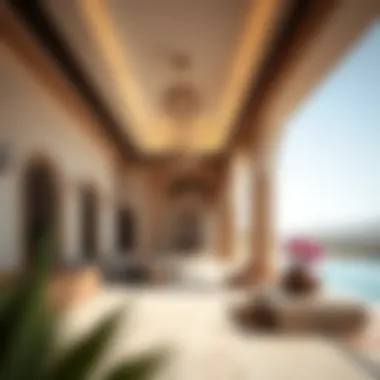

- Use of Local Materials: Using stone and clay sourced from the vicinity reduces transportation emissions and boosts the local economy.
- Water Conservation Systems: Incorporating greywater recycling and rainwater harvesting systems can help minimize water wastage in villas.
- Natural Landscaping: Selecting native plants for gardens supports biodiversity while reducing the need for excessive irrigation.
Homeowners are encouraged to consider these practices as ways to not only enhance the aesthetic appeal of their villas but also to communicate their commitment to sustainability.
"By investing in green technologies and sustainable designs, homeowners not only elevate the value of their properties but foster a healthier environment for future generations."
Integration of Technology
In the race towards modernization, the integration of technology in Arabic villas is nothing short of transformative. Significant advancements allow traditional aesthetics to coexist with modern conveniences. Key elements include:
- Smart Home Technology: Features like automated lighting, climate control, and energy monitoring options enhance the living experience.
- Integrated Security Solutions: From smart locks to surveillance cameras, technology ensures safety without compromising beauty.
- Home Entertainment Systems: Many villas now incorporate advanced sound and visual systems, providing residents with unparalleled entertainment options.
These technologies not only streamline day-to-day living but also present a luxurious lifestyle that appeals to various demographics, especially young affluent buyers. As we consider the future of Arabic villa design, it’s essential to reflect on how these modern adaptations serve to create spaces that are joyfully inviting, technologically advanced, and steeped in heritage.
The Role of Arabic Villas in Dubai's Real Estate
Arabic villas play a significant role in defining the character of Dubai's luxurious real estate market. With their intricate designs and rich cultural backgrounds, these villas represent not just homes, but the essence of tradition fused with modern living. The demand for these structures has soared alongside Dubai's reputation as a global hub for finance and tourism. Investors, homeowners, and developers are increasingly recognizing the value these villas bring to the table, both in terms of cultural heritage and financial prospects.
Investment Potential
When it comes to investing in real estate, the uniqueness of Arabic villas offers a compelling opportunity. Here are several aspects that underpin their investment potential:
- Historical Value: Properties that resonate with cultural significance tend to appreciate in value over time. Arabic villas showcase architectural styles that pay homage to the historical and cultural fabric of the region, boosting their desirability among buyers who value aesthetics and heritage.
- Luxury Appeal: The opulence associated with Arabic villa design attracts affluent buyers and tenants. Investors can benefit from higher rental yields in established neighborhoods where these villas are situated, such as Dubai Marina or Palm Jumeirah.
- Diverse Market: These villas appeal to both local buyers and international investors, increasing their marketability and thus their potential for long-term growth. This duality offers a buffer against market volatility since the demand is inherently broader and more resilient.
To exemplify, the Jumeirah area is a hotspot for these villas, where exquisite architecture and premium facilities can yield significant returns. Understanding the value of this market can guide discerning investors towards lucrative decisions.
Market Trends
The landscape of real estate in Dubai is never static, and Arabic villas are no exception. Current market trends reveal several important movements influencing their value and desirability:
- Sustainability Focus: There's a growing trend toward eco-friendly building practices. Many new developments incorporate energy-efficient systems and sustainable materials, aligning with global moves toward greener living.
- Integration with Technology: Smart home features are becoming increasingly popular. Prospective buyers are looking for homes that offer convenience through technology—whether it’s automated lighting, climate control, or high-tech security features.
- Cultural Fusion: There��’s a noticeable move towards blending traditional designs with contemporary comforts. Architects and designers are innovating by incorporating elements of Arabic architecture into modern aesthetics, appealing not just to local tastes but also to international markets.
"The evolution of Arabic villas mirrors the dynamic spirit of Dubai itself, making it essential to stay ahead of market trends and demands."
As Dubai continues to develop and attract a diverse range of inhabitants, the versatility and appeal of Arabic villas will likely flourish, keeping them relevant in the ever-changing real estate landscape. Understanding these trends is crucial for investors who wish to make informed, strategic decisions in today's market.
Culmination: The Future of Arabic Villa Design
As we reflect on the intricate world of Arabic villa design, it’s evident that the future holds a distinctive blend of respect for tradition and the demand for innovation. The architectural identity of Arabic villas isn’t merely rooted in aesthetics; it encapsulates centuries of culture, lifestyle, and social values. This concluding section emphasizes the significance of preserving historical elements while also integrating modern needs, ensuring that these living spaces continue to evolve in relevance and functionality.
Preserving Tradition
One of the paramount concerns in the realm of architecture is maintaining the delicate balance between tradition and modernity. Arabic villas, with their storied past, are not just buildings; they are legacies. The intricate tile work, the beautifully crafted mashrabiya, and the spatial organization of these structures signify a rich cultural narrative that deserves to be honored.
In preserving these elements, architects and homeowners alike must consider adaptive reuse, which involves renovating existing structures rather than tearing them down. This approach not only conserves resources but also carries forward the historically significant traits that characterize these villas. For instance:
- Authentic Materials: Utilizing local stones and traditional clay can keep the authentic character intact while enhancing sustainability.
- Traditional Design Features: Incorporating courtyards and gardens can enhance the cooling properties of the villa and provide a serene outdoor space that resonates with the original concept of open living.
Furthermore, education plays a vital role. Engaging the community and investors to foster an appreciation for these architectural styles can ensure that future generations continue to build upon this rich heritage.
Innovating for Tomorrow
To navigate the complexities of modern living, innovation in Arabic villa design is not optional but necessary. The marketplace today demands homes that embrace smart technologies and sustainable practices, aspects which were not as pressing in the past. Thus, the future of Arabic villa design hinges on effectively integrating innovation without diminishing its essence.
One of the exciting developments is the incorporation of green building technologies. For instance:
- Solar Panels: Harnessing the abundant sunlight characteristic of the region can drastically reduce energy costs and environmental impact.
- Rainwater Harvesting: Designing villas that incorporate eco-friendly water management systems can address the pressing issue of water scarcity.
Moreover, embracing contemporary design principles—think sleek lines, open-plan spaces—while using traditional aesthetics can attract a broader demographic, particularly younger homebuyers. Finding a way to blend these innovative practices into the fabric of Arabic villa design ensures they remain relevant in a rapidly changing world.
“The masterpiece of the future will be constructed not only of stone and wood but of a vision that links past and future.”
In summary, the continued exploration of Arabic villa design holds endless possibilities, balancing heritage with modern necessities. As society evolves, so too should the spaces we inhabit, allowing us to appreciate our rich past while adapting for tomorrow.






